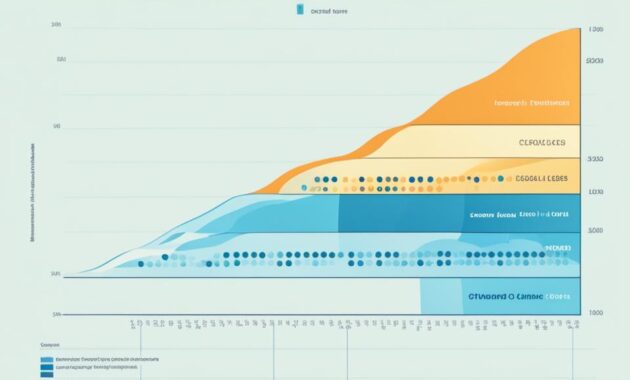Going to university can cost a lot, but the US government helps with financial aid. The U.S. Department of Education gives out grants, loans, and work-study jobs to many students every year. By filling out the Free Application for Federal Student Aid (FAFSA), students can get different kinds of loans and financial help.
Every year, the U.S. Department of Education gives over $120 billion to about 13 million students. This money comes from grants, work-study jobs, and low-interest loans. These aids make going to university easier and cheaper for students from all backgrounds. This way, they can study without worrying too much about money.
Key Takeaways
- Federal Student Aid offers grants, loans, and work-study opportunities to help students pay for higher education
- Students can access government student loans online and other forms of financial assistance by completing the FAFSA
- Tuition fee loans and maintenance loans are available to help cover the costs of attending university or career school
- The U.S. Department of Education provides over $120 billion in financial aid to approximately 13 million students each year
- Government student loans and other forms of student finance make higher education more accessible and affordable for students from diverse backgrounds
Types of Federal Student Aid
The U.S. Department of Education offers different kinds of financial help for college or career school. These include grants, loans, and work-study jobs. Each type is for different student needs and situations.
Grants
Grants are a kind of aid you don’t have to pay back. They’re great for students who really need financial help. The main grants are:
- Pell Grants
- Federal Supplemental Educational Opportunity Grants (FSEOG)
- Teacher Education Assistance for College and Higher Education (TEACH) Grants
- Iraq and Afghanistan Service Grants
To get these grants, you need to fill out the Free Application for Federal Student Aid (FAFSA).
Loans
Loans are money you borrow that you have to pay back with interest. They have flexible repayment plans and lower interest rates than private loans. The main types are:
- Direct Subsidised Loans
- Direct Unsubsidised Loans
- Direct PLUS Loans (for graduate students, professional students, and parents)
- Direct Consolidation Loans
How much you can borrow depends on your school year, if you’re dependent or independent, and your school’s costs.
Work-study
The Federal Work-Study Programme gives part-time jobs to students who need money for school. These jobs can be on or off campus and match your study or community service interests.
To get a work-study job, you must fill out the FAFSA and say you want work-study. How much you can earn is based on your school’s financial aid office.
| Type of Aid | Description | Repayment Required |
|---|---|---|
| Grants | Need-based financial aid that does not require repayment | No |
| Loans | Borrowed funds that must be repaid with interest | Yes |
| Work-study | Part-time jobs that allow students to earn money for education expenses | No |
Knowing about the different federal student aid can help students make smart choices about paying for school. This way, they can reduce their debt later.
Free Application for Federal Student Aid (FAFSA)
The FAFSA is key to getting financial help for college in the US. It lets students apply for federal grants, loans, and work-study jobs. By filling it out, students see if they can get aid based on their financial situation and other factors.
The FAFSA is easy to use and open to all students. You can fill it out on the official FAFSA website. There, you’ll answer questions about your family’s money, your plans, and personal details. It’s important to give correct and current info to get the most aid you can.
To get federal student aid, you must meet some rules. You must be a US citizen or eligible non-citizen, have a high school diploma or similar, and be in a college or university programme. Guys aged 18 to 25 must also sign up with the Selective Service System.
“Completing the FAFSA is a critical step in making higher education more affordable and accessible for millions of students across the country.” – U.S. Secretary of Education Miguel Cardona
The FAFSA opens on October 1st every year. Students should apply early to increase their chances of getting aid. Deadlines for FAFSA vary by state and college, so check them out.
By applying online and meeting the rules, students can get many aid options. This help can really help them go to college and reach their goals.
Estimating College Costs
Before choosing a university or college, it’s key to know the costs. Things like tuition, accommodation, books, and living costs add up fast. It’s vital to get the total cost right. Luckily, online tools and calculators can help students and their families understand the costs of higher education.
Online Tools and Calculators
Many colleges offer online cost calculators on their websites. Students can enter details like their course, living arrangements, and financial aid info. These calculators show estimated costs, helping students see what they might spend. Some top online calculators are:
- The College Board’s Net Price Calculator
- The U.S. Department of Education’s College Scorecard
- The National Center for Education Statistics’ College Navigator
Using these tools, students can see the costs of attending a certain college. This helps them make better choices for their future.
Comparing Schools
With estimated costs in hand, students can compare schools to find the best deal. When looking at schools, consider:
- Tuition and other costs
- Financial aid and scholarships
- Living costs in the area
- Job prospects and salary after graduation
By looking at these things, students can pick a college that fits their budget, goals, and future plans. This careful comparison is key to making a good choice.
Repayment Plans for Student Loans
Repaying your student loans needs a good plan. Knowing about repayment plans and picking the right one for your finances is key. This helps you manage your debt well. By paying on time and keeping costs down, you can handle your student loans.
Making Timely Payments
On-time payments are crucial for repaying student loans. Late or missed payments bring extra fees and harm your credit score. Here are some tips to stay on track:
- Set up automatic payments through your loan servicer
- Create a budget that prioritises your student loan payments
- Keep track of your payment due dates and make payments on time
- If you anticipate difficulty making a payment, contact your loan servicer immediately to discuss your options
Keeping Costs Manageable
Keeping your student loan costs manageable is also key. Here are ways to lower your loan debt:
- Consider an income-driven repayment plan, which bases your monthly payments on your income and family size
- Make extra payments when possible to reduce the principal balance and overall interest charges
- Take advantage of student loan interest deductions on your taxes
- Look into loan forgiveness programmes, such as Public Service Loan Forgiveness, if you work in a qualifying field
| Repayment Plan | Monthly Payment | Repayment Term |
|---|---|---|
| Standard | Fixed | 10 years |
| Graduated | Lower initial payments that increase every 2 years | 10 years |
| Extended | Fixed or graduated | 25 years |
| Income-Driven | Based on income and family size | 20-25 years |
If you are struggling to repay your student loan, contact your loan servicer to discuss your options and find a solution that works for you.
Understanding repayment plans, paying on time, and keeping costs down helps you manage your student loans. This way, you can reach your goals in education and finance.
Consequences of Not Paying Student Loans
Not paying your student loans on time can lead to serious issues, like defaulting on them. This can badly affect your finances and future chances.
Here are some possible outcomes of student loan default:
- Damage to your credit score, making it hard to get credit later
- Garnishment of your wages or tax refunds to pay off the loan
- Loss of eligibility for more federal student aid
- Legal action taken against you by the loan holder
- Difficulty getting a job or renting a place due to bad credit
If you’re finding it hard to pay your student loans, look into repayment options before you default. Talk to your loan servicer about plans like income-driven repayment or consolidation. These can make your payments easier to manage.
Don’t let student loan default ruin your financial future. Act now to keep up with your payments and get help if you need it.
Defaulting on your loans isn’t a fix for your money problems. By tackling your repayment issues and looking into your options, you can avoid the big problems of student loan default. This way, you can keep your finances stable.
Saving on A Valuable Education (SAVE) Income-Driven Repayment Plan
The U.S. Department of Education has launched a new plan called SAVE for student loans. This plan offers easier repayment options. It helps borrowers manage their loans and reach their career goals.

Enrollment Numbers
Since starting, the SAVE plan has attracted a lot of interest. Over 4 million borrowers have joined. This shows how popular and effective the plan is for managing student loans.
Transition from Revised-Pay-As-You-Earn (REPAYE) Plan
Before SAVE, many were on the REPAYE plan. REPAYE made payments affordable based on income and family size. Now, those on REPAYE have moved to SAVE easily, continuing their repayment smoothly.
Switching from REPAYE to SAVE offers more benefits and flexibility. SAVE adds new features to help with repayment. The move shows the Department’s effort to make repayment easier and give borrowers the best options.
More borrowers are joining SAVE and leaving REPAYE behind. This new plan is changing lives by making loans easier to handle. It lets people focus on their education without worrying about debt.
Federal Student Aid’s Performance and Strategic Plan
Federal Student Aid (FSA) aims to give clear and full info on its programs, work, and results. It makes a five-year strategic plan. This plan shows its mission, goals, and aims for the future. It acts as a guide for FSA to make higher education more accessible, help students succeed, and use taxpayer money wisely.
FSA also releases yearly reports. These reports give deep insights into how it’s doing and its progress towards its goals. They cover things like how many students it helps, the aid given out, and loan default rates. This shows FSA’s dedication to being open and responsible.
The strategic plan and yearly reports are key for seeing what FSA focuses on and how well it does its job. They give important info for those who make education policies, teachers, and the public. This helps with decisions on funding and support for higher education. By setting clear goals and checking its progress, FSA aims to get better at serving students and their families.
“Our strategic plan and annual reports are more than just documents; they represent our commitment to the millions of students who rely on our programmes to achieve their educational dreams.” – Richard Cordray, Chief Operating Officer of Federal Student Aid
FSA is looking ahead with its strategic plan. It will help guide efforts to make higher education more accessible, improve student results, and protect its programs’ integrity. With ongoing checks and reports, FSA will stay open to the public. It will keep working hard to make sure every student can get a top-quality education.
Applying for Federal Grants, Loans, and Work-Study
Getting federal financial aid for college is key to making your dreams come true. The U.S. Department of Education offers grants, loans, and work-study programs. These help students pay for their education. You need to fill out the Free Application for Federal Student Aid (FAFSA) to get these funds.
The FAFSA is vital for students wanting federal aid. It shows your financial situation to see if you qualify for aid. Most students fill it out online at FAFSA on the Web.
FAFSA on the Web
FAFSA on the Web makes applying for aid easy. It guides you step by step and is user-friendly. The online version is quicker and checks for mistakes.
When applying online, you’ll need personal and financial details like your social security number and bank statements. Make sure you have all your documents ready. Remember, you must apply every year to keep getting aid.
Visit StudentAid.gov for all you need to know about federal aid for college. Applying for aid is free! Last year, over 21 million students filled out the FAFSA, many online at FAFSA on the Web.
Looking for more ways to pay for college is also smart. Many students use grants, loans, and work-study together. By checking out mortgage lenders, you might find low-interest loans to add to your aid.
To fund your college, know what resources are out there and act on them. By filling out the FAFSA online and looking at other options, you can reach your goals without too much debt.
Resources for Students and the Public
The U.S. Department of Education offers many resources for students and the public. These help with understanding and managing student loans. Key resources include StudentAid.gov and the Federal Student Aid Information Center.
StudentAid.gov is a detailed website about federal student aid. It covers grants, loans, work-study programmes, and the FAFSA. The site has tools like loan repayment calculators and college cost estimators. It also guides on loan repayment options, including the SAVE plan for managing payments.
Federal Student Aid Information Center
For one-on-one help, students and the public can call the Federal Student Aid Information Center. At 1-800-4-FED-AID, experts can answer aid programme questions, help with the FAFSA, and guide on loan repayment. This centre is great for extra support with financial aid or specific questions.
These resources help students and families make smart choices about education funding. With StudentAid.gov’s info and the Federal Student Aid Information Center’s support, they can reach their goals and stay financially stable.







